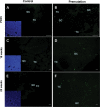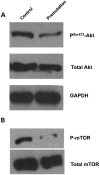Fragile X premutation RNA is sufficient to cause primary ovarian insufficiency in mice
- PMID: 22914733
- PMCID: PMC3490511
- DOI: 10.1093/hmg/dds348
Fragile X premutation RNA is sufficient to cause primary ovarian insufficiency in mice
Abstract
Spontaneous 46,XX primary ovarian insufficiency (POI), also known as 'premature menopause' or 'premature ovarian failure', refers to ovarian dysfunction that results in a range of abnormalities, from infertility to early menopause as the end stage. The most common known genetic cause of POI is the expansion of a CGG repeat to 55-199 copies (premutation) in the 5' untranslated region in the X-linked fragile X mental retardation 1 (FMR1) gene. POI associated with the FMR1 premutation is referred to as fragile X-associated POI (FXPOI). Here, we characterize a mouse model carrying the human FMR1 premutation allele and show that FMR1 premutation RNA can cause a reduction in the number of growing follicles in ovaries and is sufficient to impair female fertility. Alterations in selective serum hormone levels, including FSH, LH and 17β-estradiol, are seen in this mouse model, which mimics findings in humans. In addition, we also find that LH-induced ovulation-related gene expression is specifically altered. Finally, we show that the FMR1 premutation allele can lead to reduced phosphorylation of Akt and mTOR proteins. These results together suggest that FMR1 premutation RNA could cause the POI associated with FMR1 premutation carriers, and the Akt/mTOR pathway may serve as a therapeutic target for FXPOI.
Figures






Similar articles
-
Granulosa cell and oocyte mitochondrial abnormalities in a mouse model of fragile X primary ovarian insufficiency.Mol Hum Reprod. 2016 Jun;22(6):384-96. doi: 10.1093/molehr/gaw023. Epub 2016 Mar 9. Mol Hum Reprod. 2016. PMID: 26965313 Free PMC article.
-
Presence of inclusions positive for polyglycine containing protein, FMRpolyG, indicates that repeat-associated non-AUG translation plays a role in fragile X-associated primary ovarian insufficiency.Hum Reprod. 2016 Jan;31(1):158-68. doi: 10.1093/humrep/dev280. Epub 2015 Nov 3. Hum Reprod. 2016. PMID: 26537920 Free PMC article.
-
FMR1 and the continuum of primary ovarian insufficiency.Semin Reprod Med. 2011 Jul;29(4):299-307. doi: 10.1055/s-0031-1280915. Epub 2011 Oct 3. Semin Reprod Med. 2011. PMID: 21969264 Review.
-
Evidence for a fragile X messenger ribonucleoprotein 1 (FMR1) mRNA gain-of-function toxicity mechanism contributing to the pathogenesis of fragile X-associated premature ovarian insufficiency.FASEB J. 2022 Nov;36(11):e22612. doi: 10.1096/fj.202200468RR. FASEB J. 2022. PMID: 36250920 Free PMC article.
-
[FMR1 PREMUTATION CARRIERS - ARE THEY REALLY ASYMPTOMATIC?].Harefuah. 2018 Apr;157(4):241-244. Harefuah. 2018. PMID: 29688643 Review. Hebrew.
Cited by
-
Approaches to identify genetic variants that influence the risk for onset of fragile X-associated primary ovarian insufficiency (FXPOI): a preliminary study.Front Genet. 2014 Aug 7;5:260. doi: 10.3389/fgene.2014.00260. eCollection 2014. Front Genet. 2014. PMID: 25147555 Free PMC article.
-
FMR1 premutation is an uncommon explanation for premature ovarian failure in Han Chinese.PLoS One. 2014 Jul 22;9(7):e103316. doi: 10.1371/journal.pone.0103316. eCollection 2014. PLoS One. 2014. PMID: 25050920 Free PMC article.
-
Granulosa cell and oocyte mitochondrial abnormalities in a mouse model of fragile X primary ovarian insufficiency.Mol Hum Reprod. 2016 Jun;22(6):384-96. doi: 10.1093/molehr/gaw023. Epub 2016 Mar 9. Mol Hum Reprod. 2016. PMID: 26965313 Free PMC article.
-
FMR1 and AKT/mTOR Signaling in Human Granulosa Cells: Functional Interaction and Impact on Ovarian Response.J Clin Med. 2021 Aug 30;10(17):3892. doi: 10.3390/jcm10173892. J Clin Med. 2021. PMID: 34501340 Free PMC article.
-
MicroRNA-4516 in Urinary Exosomes as a Biomarker of Premature Ovarian Insufficiency.Cells. 2022 Sep 7;11(18):2797. doi: 10.3390/cells11182797. Cells. 2022. PMID: 36139370 Free PMC article.
References
-
- Nelson L.M. Clinical practice. Primary ovarian insufficiency. N. Engl. J. Med. 2009;360:606–614. doi:10.1056/NEJMcp0808697. - DOI - PMC - PubMed
-
- Gallagher J.C. Effect of early menopause on bone mineral density and fractures. Menopause. 2007;14:567–571. doi:10.1097/gme.0b013e31804c793d. - DOI - PubMed
-
- Jacobsen B.K., Knutsen S.F., Fraser G.E. Age at natural menopause and total mortality and mortality from ischemic heart disease: the Adventist Health Study. J. Clin. Epidemiol. 1999;52:303–307. doi:10.1016/S0895-4356(98)00170-X. - DOI - PubMed
-
- Mondul A.M., Rodriguez C., Jacobs E.J., Calle E.E. Age at natural menopause and cause-specific mortality. Am. J. Epidemiol. 2005;162:1089–1097. doi:10.1093/aje/kwi324. - DOI - PubMed
-
- Popat V.B., Calis K.A., Vanderhoof V.H., Cizza G., Reynolds J.C., Sebring N., Troendle J.F., Nelson L.M. Bone mineral density in estrogen-deficient young women. J. Clin. Endocrinol. Metab. 2009;94:2277–2283. doi:10.1210/jc.2008-1878. - DOI - PMC - PubMed
Publication types
MeSH terms
Substances
Grants and funding
LinkOut - more resources
Full Text Sources
Medical
Molecular Biology Databases
Miscellaneous

